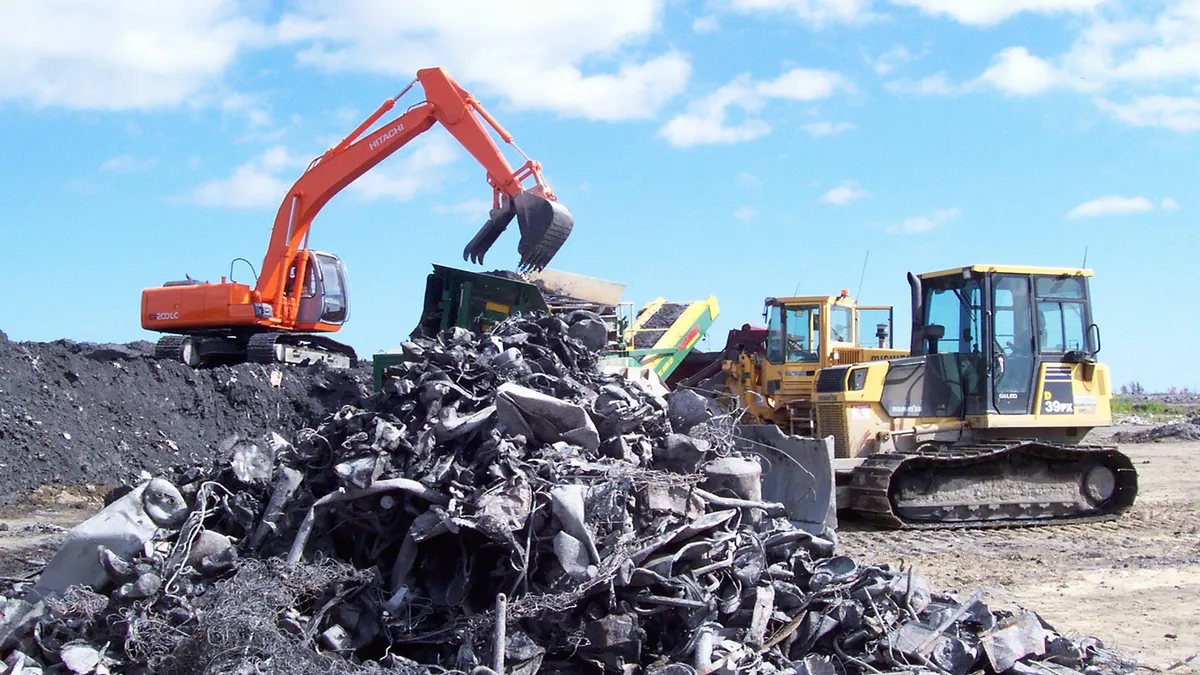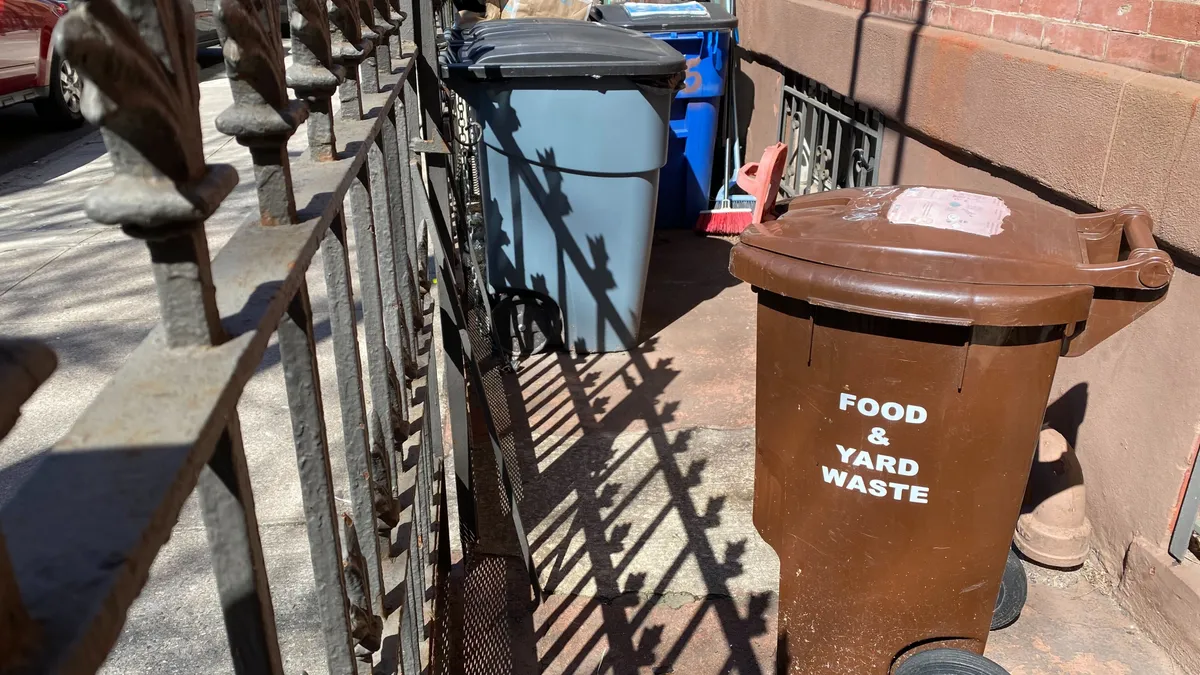While many of waste and recycling's core functions haven't changed too drastically coming into 2017, the year has just begun — and following 2016, it's safe to say that anything can happen. Luckily, there is time to prepare.
In the same way that organic waste and glass became the talk of 2016, there are new topics to buzz about this year that will likely transform the way the industry operates. Based on conversations with industry figures and our own observations, here are the trends that Waste Dive will be watching in 2017.
1. Commodity prices likely to make a comeback
The harsh effects of low prices for many commodities have been no secret over the past two years, though some believe that 2015 marked the bottom of that trend. Paper remains stronger than others though still below average. Aluminum prices are also still below their recent 2014 peak though have been steadily rising over the past year. Copper has also seen a bump lately and an increase in steel prices has been reported as well. Oil prices continue to be the main driver in pricing for various types of plastic and while they're also still below the recent 2014 peak there are early signs of a rebound this year.
While some of these signs are optimistic, the past few years of uncertainty could still affect the way multiyear contracts are structured. How fast these values will rise, and whether it will be enough to make a difference for municipalities and haulers that have been dealing with low-value material, remains unclear. Regional processing options are also a key factor, especially for challenging material such as glass.
2. Recyclers to move away from weight-based goals
Recent commodity fluctuations, as well as a move toward lighter packaging, has led some of the industry's biggest companies to rethink their standard weight-based metrics. Waste Management announced a move away from weight-based goals in favor of measuring greenhouse gas reduction in its recently released 2016 sustainability report. CEO Jim Fish called such goals "often costly, sometimes abstract, and frequently difficult to achieve" in his annual letter. Republic Services CEO Don Slager also had similar thoughts on recycling last year, stating that the company would not be entering any long-term contracts with decreasing values over time among other opinions.
The concept of looking at environmental effects of materials over their full lifecycle has been a priority of the EPA and other organizations for years. Especially with single-stream collection becoming the new norm for many communities, recyclers are looking for ways to recoup more value from this mixed and contaminated material stream.
In cities with high diversion rates or "zero waste" goals, the weight-based approach is still in play. The recently approved commercial waste franchise agreement in Los Angeles — which includes both Waste Management and Republic — has financial penalties for failing to meet diversion targets. Those goals are not mutually exclusive from reducing greenhouse gas emissions, but it will be interesting to watch whether new contract language can find a way to merge the two concepts into clear terms.
3. Flexible packaging to continue growing (and presenting challenges)
From snack pouches to pet food bags, the flexible plastic packaging market is growing at a rate that will be hard for recyclers to ignore. Few operations are set up to recover this material or deal with its multi-layer composition. Some say they've found potential to upgrade equipment at MRFs to separate the material and others have said the best option may be energy recovery technology such as gasification. Last year, Dow Chemical announced a new type of polyethylene-based barrier packaging that will be more widely available soon and is seen as one possible solution.
At face value this type of packaging may actually be more sustainable because it uses less material, but those environmental benefits can be canceled out if a viable recovery solution isn't developed. Recycling professionals are expected to work with brands on design specifications, as they've done with other types of products, to see if more can be done to ensure that this material has better end-of-life options. In the meantime, companies and municipalities will likely see flexible packaging become an even bigger part of their waste stream in 2017.
4. Shifts in politics to create more division
The U.S. is about to enter a new political era and, as reflected by reader surveys, many are still divided on what this will mean for the waste and recycling industry. Will the Trump administration change trade policies with China or Mexico, and in-turn affect commodity prices? Is the Trans-Pacific Partnership, supported by groups such as the Institute of Scrap Recycling Industries, truly dead on President-elect Trump's first day in office as previously promised? Will nominees such as Scott Pruitt and Rex Tillerson influence major changes in U.S. environmental policy if they can make it through their Senate confirmation hearings?
On an even larger scale, Trump's shifting skepticism of climate change may be at odds with a growing recognition of its scope in the industry. Waste Management and Republic Services were both recognized by the nonprofit Carbon Disclosure Project on its 2016 Climate A List for their mitigation efforts and emissions reduction has driven many other trends within the industry. Major international policy shifts — such as disavowing the Paris Agreement — could affect the U.S.'s environmental standing around the world in the same way that the decision by voters to exit the European Union has done for the U.K.
Regardless of what happens federally, many observers agree that any major environmental action in the next few years is likely to happen at the state or local level. California Governor Jerry Brown signed multiple laws around emissions reduction last year and has vowed to continue such action going forward. As other new governors and state legislators take office this month, more policy changes could be on the way. At the local level, where many of the industry's daily operations are most affected, campaign season has only just begun. Local officials — including first-term mayors in cities such as New York, Los Angeles and Boston — are all up for re-election this year. While waste-related issues weren't a main factor in any of their first races, each city's waste system is dealing with its own transitional period right now and anything could happen.
5. Increased infrastructure spending to present competitive opportunities
Increased economic activity is often linked to increased waste generation, and Trump has promised big plans for infrastructure spending in the coming years. Unlike per capita waste generation, which hasn't risen at the rate of personal consumer expenditures — possibly due to lighter packaging — major construction projects are guaranteed to create waste. This construction and demolition (C&D) debris will need to be hauled by someone, and companies will need to be prepared with appropriate equipment and manpower in order to bid on such opportunities.
Kevin Kraushaar, interim-CEO of the National Waste & Recycling Association, highlighted this as a key priority in an interview with Waste Dive last month. Some readers also said infrastructure spending would be good for business in a summer survey and post-election responses collected by Waste Dive last year. Ensuring that companies are ready for these projects and have capacity to handle the resulting tonnage increases will be important for the industry to deliver an efficient response to any potential developments.
6. Technology to transform operations — whether or not the industry is ready
While technology has been quickly transforming many industries including retail, construction and healthcare, the waste industry has been slow to adapt to the inevitable "Internet of Things" (IoT) sweeping the globe. As International Solid Waste Association (ISWA) President Antonis Mavropoulos explained at a recent discussion about the future of waste, the industry is bound to be entirely disrupted by technology soon — and many innovations are already starting to be implemented.
Aside from keeping up with trends, increased use of technology and data analysis across the industry will have many applications to make operations more efficient, safe and environmentally protective. The increased use of drones on landfill sites is expected to help track the growth of landfill cells and make monitoring more cost-efficient. Sorting and dismantling robots will increase waste diversion and account for more precise separation. Fleet management software and cloud-based applications will continue to improve both route logistics and internal communications. Even proposed driverless garbage trucks could solve a recent driver shortage crisis while potentially making collections more efficient.
While these technological trends sound futuristic to the common industry professional, they are bound to become normalized sooner than some may think. In order to prepare for a more digital age, owners and executives will need to consider recruiting employees that can increase technological initiatives and make sense of data in order to stay competitive.






















